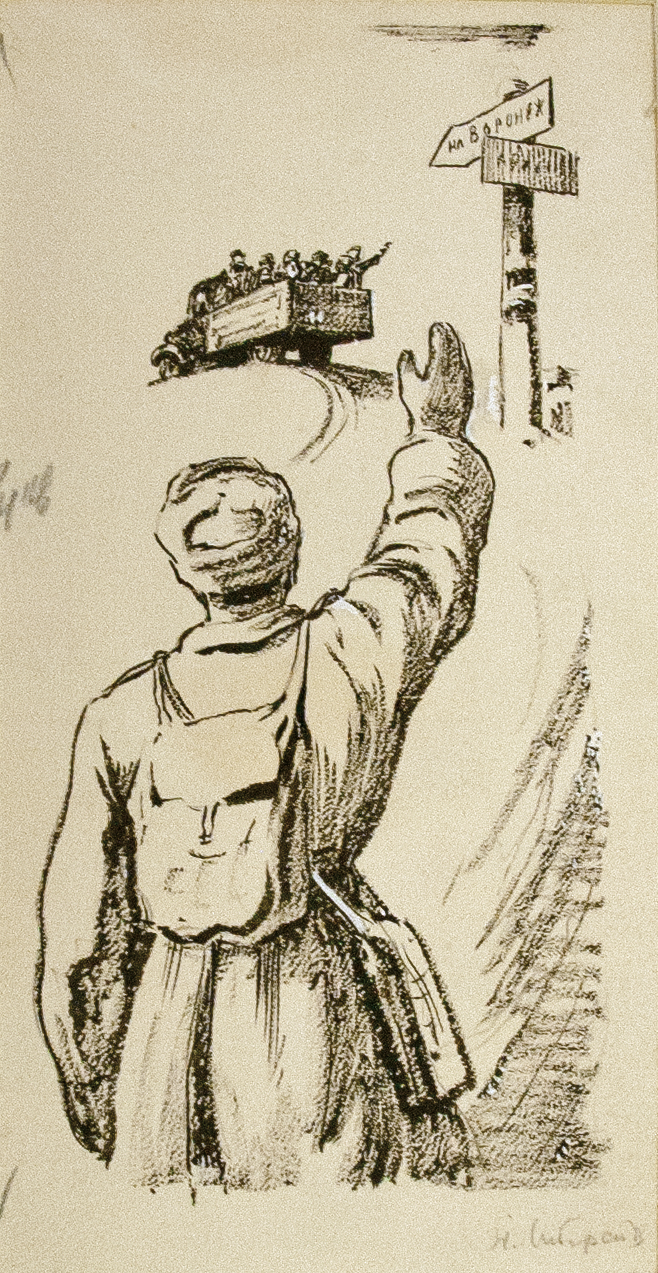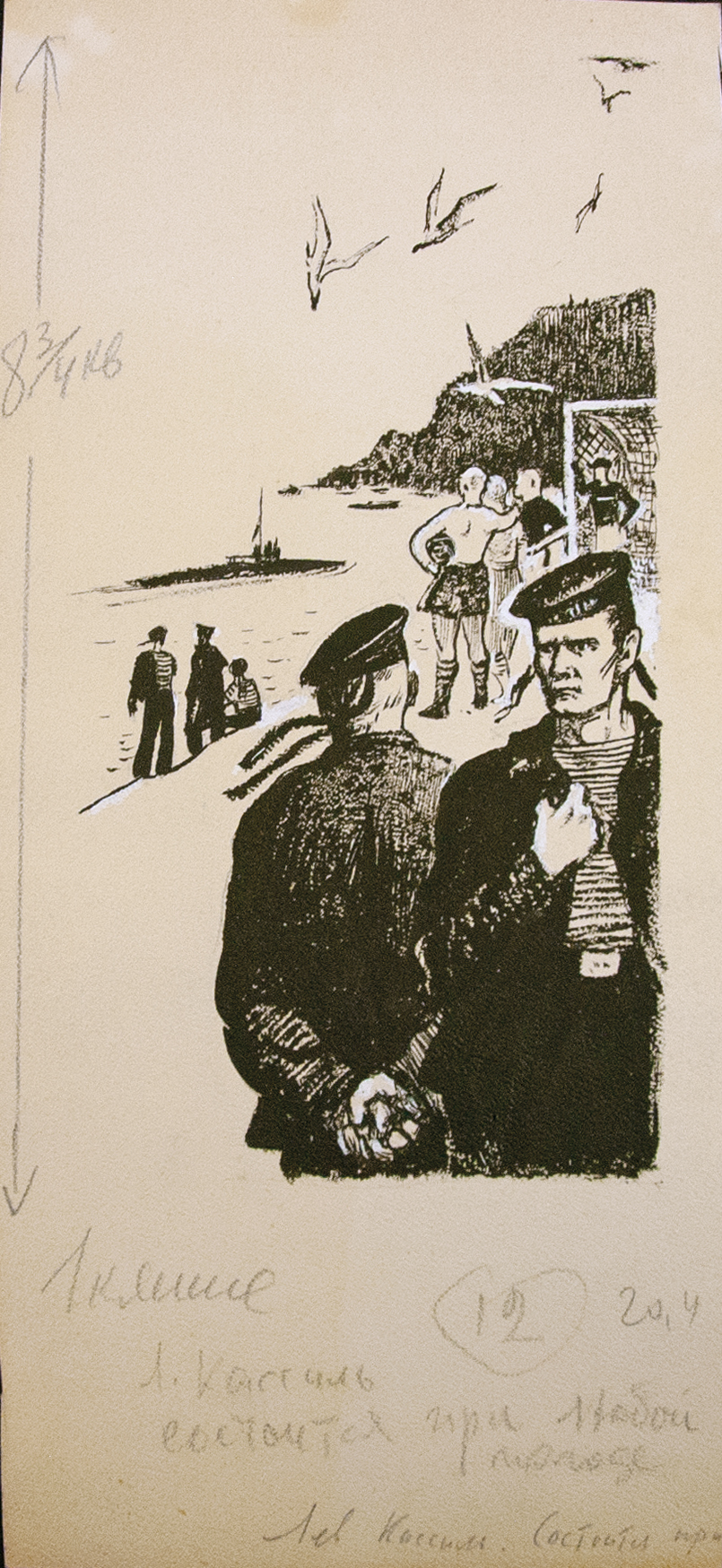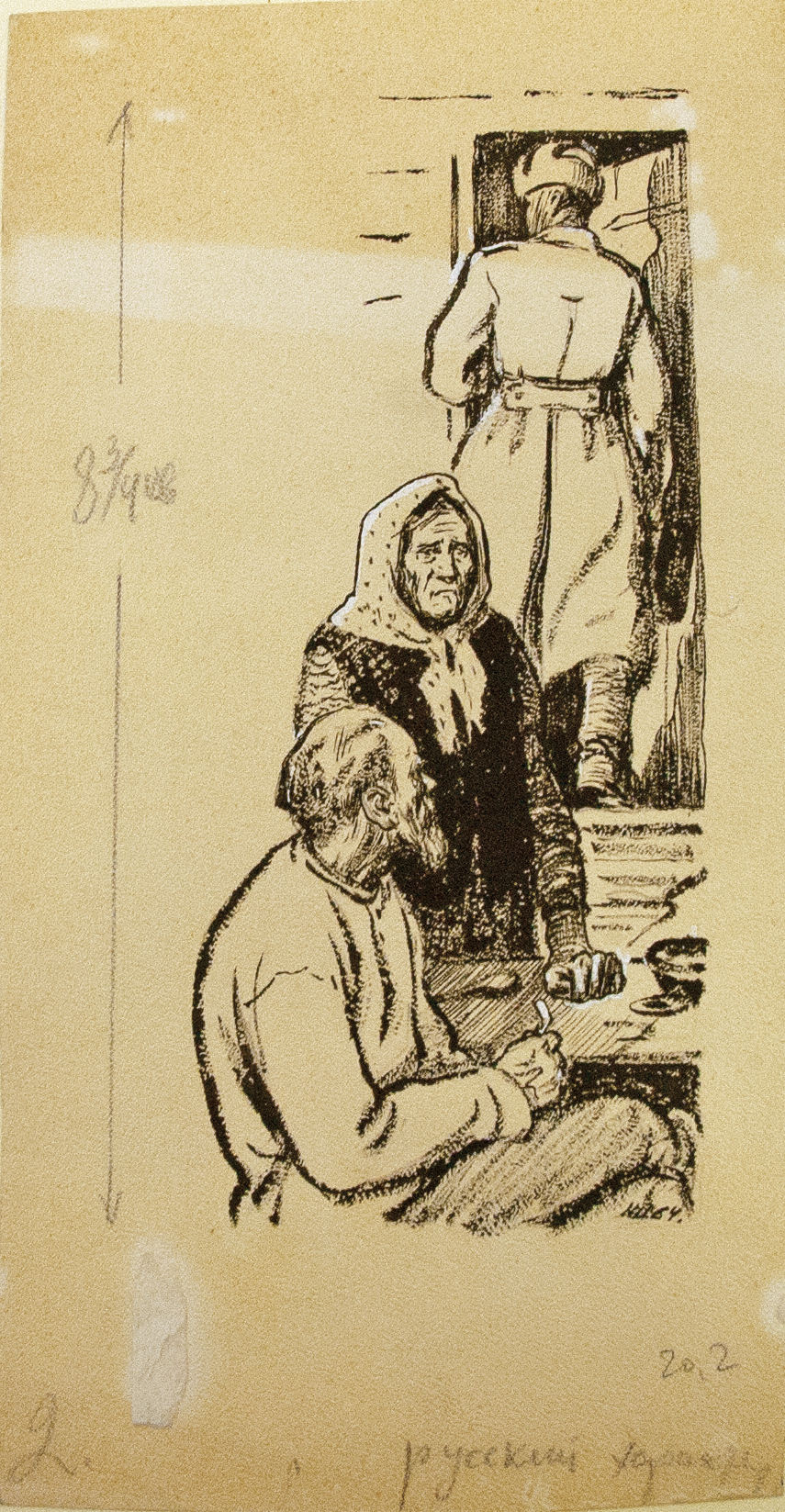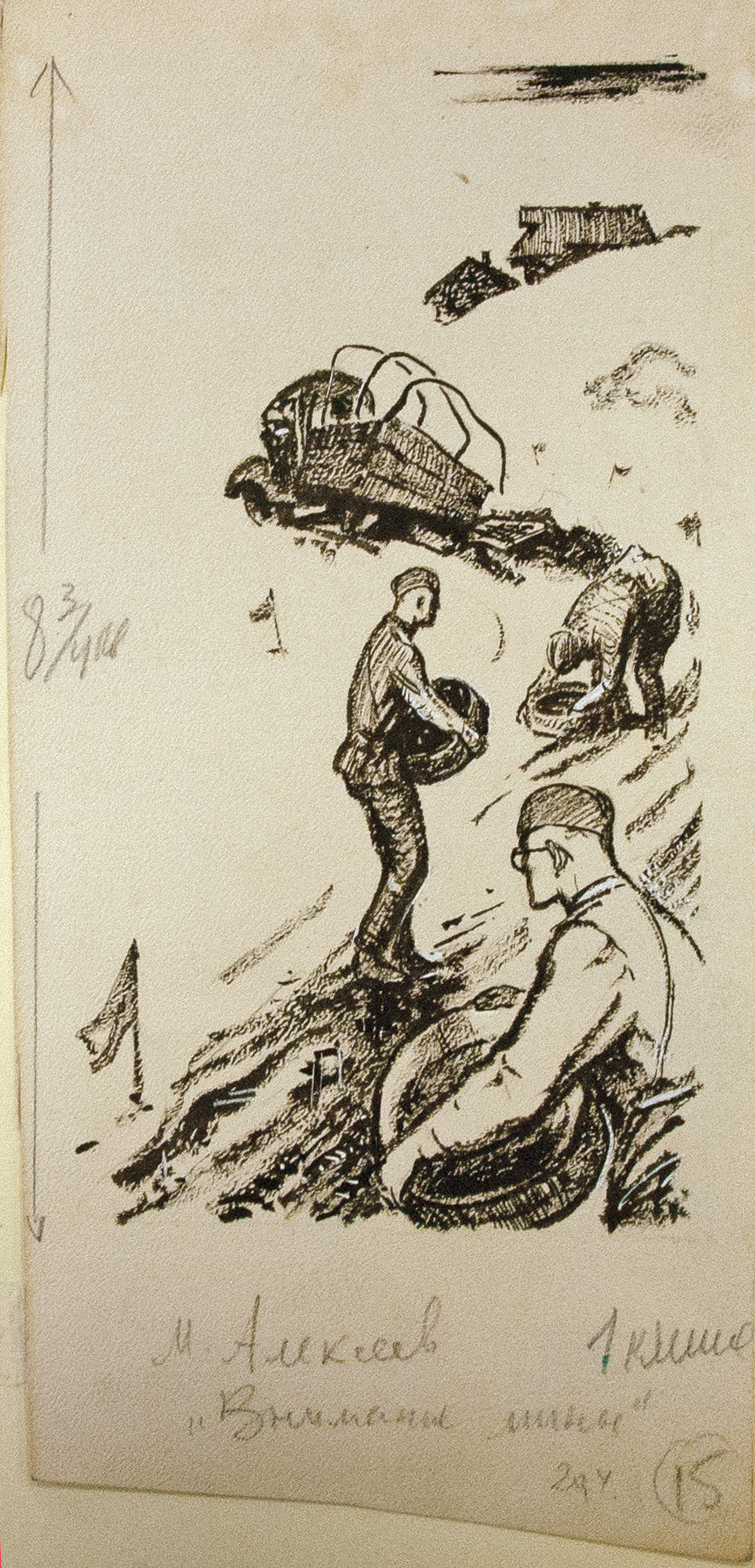Red Etchings
Alexander Samokhvalov
Alexander Samokhvalov
Alexander Samokhvalov
Nikolay Ushin
Nikolay Ushin
Nikolay Ushin
Nikolay Sheberstov
Nikolay Sheberstov
Nikolay Sheberstov
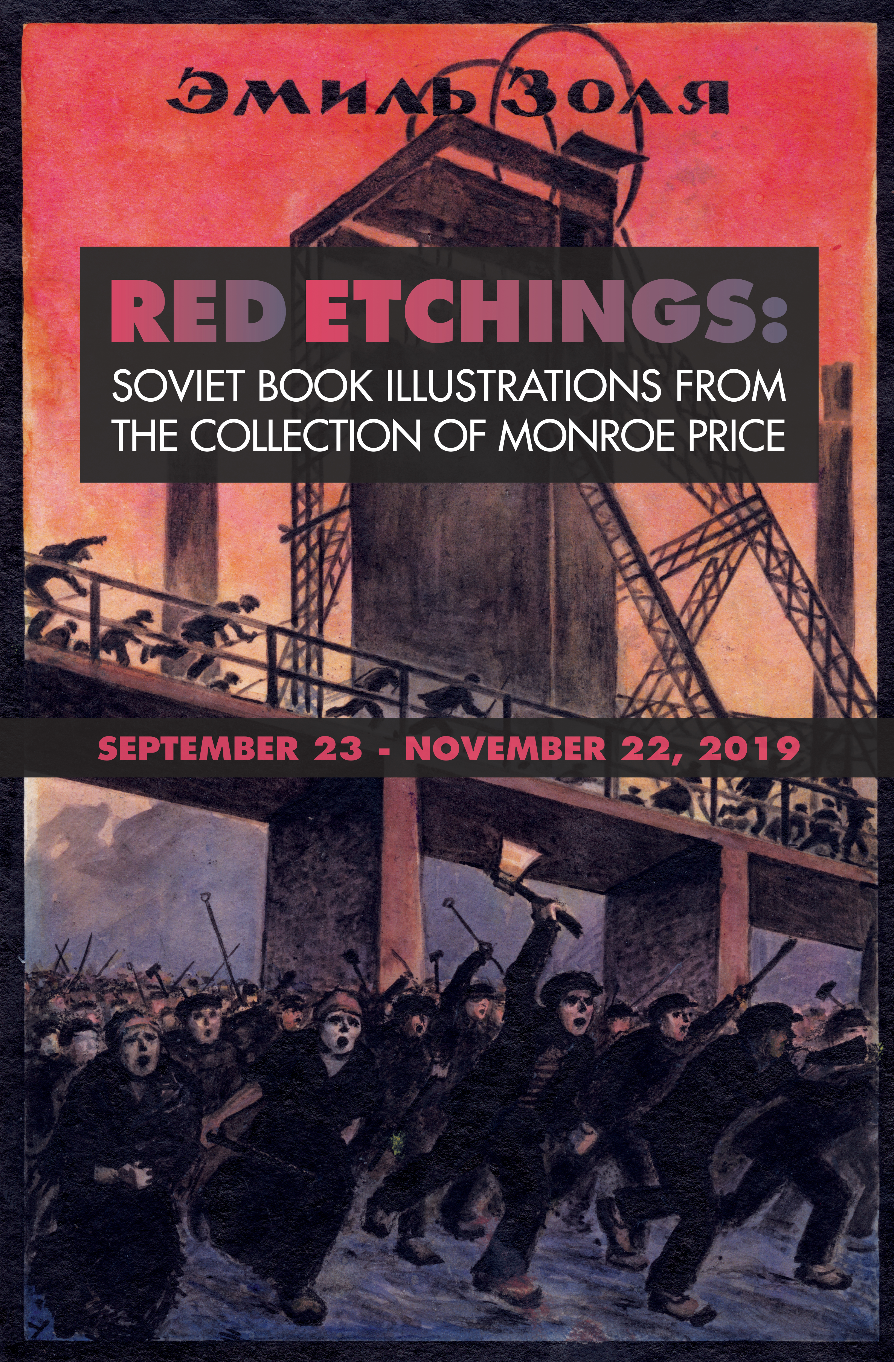
On exhibit September 23, 2019 - November 22, 2019
Curated by Sofia Verba
Following the 1917 Revolution, Russian authorities encouraged the development of book design as a means of communicating official Soviet ideology. Many artists—both famous and unknown—were commissioned to create book illustrations. This exhibition focuses on four of them: Zoya Kruzhkova, Alexander Samokhvalov, Nikolay Ushin, and Nikolay Sheberstov, whose works reflect the three stages of the art form’s development: the 1920s, 1950s, and 1980s. The exhibition features book covers, original prints, and draft designs for Soviet-era novels as well as 19th-century reprints.
The gems of the collection are two original lithographs by Alexander Samokhvalov. Most famous for his paintings—considered Russian classics of the 1920s-1930s—he was also an accomplished book illustrator. Other highlights include an etching by Zoya Khruzhkova for the now-forgotten pre-revolutionary Russian novel The Adventure of Blue Banknote, as well as draft designs by Nikolay Ushin and Nikolay Shebertsov with marks and corrections that reveal the book design process.
Introduction

Illustration for Adventures of the Blue Banknote by Evgeny Grebenka
1980
Etching
Zoya Kruzhkova (b. 1947) is an artist best known for her etchings, lithographs, watercolors, and pastels. The exhibition features an etching for the now-forgotten pre-revolutionary Russian novella The Adventures of the Blue Banknote.
Alexander Samokhvalov (1894-1971) is one of the most famous social realist artists. His paintings are considered Soviet classics and he was an accomplished book illustrator as well. Two of his lithographs are among the gems in the collection.
Mikhail Saltykov-Shchedrin was a 19th-century Russian satirical writer. His writings, which illustrated and ridiculed corruption, bureaucracy, everyday absurdities, and other flaws in the system of Imperial Russia, were especially praised during Soviet times. Saltykov-Shchedrin's farcical history of Glupov (or Stupid Town), one of the major Russian satirical novels of the 19th century, was on the mandatory reading list for secondary schools in the USSR. Illustrations by Alexander Samokhvalov were a great success and won a Grand Prix at the 1937 Paris International Exposition.
Alexander Samokhvalov (1894-1971) is one of the most famous social realist artists. His paintings are considered Soviet classics and he was an accomplished book illustrator as well. Two of his lithographs are among the gems in the collection.
Mikhail Saltykov-Shchedrin was a 19th-century Russian satirical writer. His writings, which illustrated and ridiculed corruption, bureaucracy, everyday absurdities, and other flaws in the system of Imperial Russia, were especially praised during Soviet times. Saltykov-Shchedrin's farcical history of Glupov (or Stupid Town), one of the major Russian satirical novels of the 19th century, was on the mandatory reading list for secondary schools in the USSR. Illustrations by Alexander Samokhvalov were a great success and won a Grand Prix at the 1937 Paris International Exposition.
Nikolay Ushin (1898-1942) is famous for both his stage designs and book illustrations. His illustrations for One Thousand and One Nights won the golden medal at the International Exposition of Art and Technology in Paris in 1937. The cover-design draft on exhibit was created for the Leningrad publishing house “Priboy”—the first legal Bolshevik party publishing house, founded in 1912.
Nikolay Ushin (1898-1942) is famous for both his stage designs and book illustrations. His illustrations for One Thousand and One Nights won the golden medal at the International Exposition of Art and Technology in Paris in 1937. The cover-design draft on exhibit was created for the Leningrad publishing house “Priboy”—the first legal Bolshevik party publishing house, founded in 1912.

Nikolay Sheberstov (1917-?) created both book illustrations and propaganda posters. His most famous book illustrations accompanied the Russian translation of Les Rougon-Macquart by Émile Zola. One of 19th-century France’s foremost novelists, Zola was sympathetic to socialism and thus published extensively in the USSR. Sheberstov also provided illustrations for various Soviet-era novels. His designs constitute the largest part of the collection. Most pieces on view are draft designs for Novellas and Short Stories (1965). They include marks and corrections that reveal the book design process. Novellas was a popular WWII-themed book that contained stories by famous Soviet writers and sold over one hundred thousand copies.


Nikolay Sheberstov (1917-?) created both book illustrations and propaganda posters. His most famous book illustrations accompanied the Russian translation of Les Rougon-Macquart by Émile Zola. One of 19th-century France’s foremost novelists, Zola was sympathetic to socialism and thus published extensively in the USSR. Sheberstov also provided illustrations for various Soviet-era novels. His designs constitute the largest part of the collection. Most pieces on view are draft designs for Novellas and Short Stories (1965). They include marks and corrections that reveal the book design process. Novellas was a popular WWII-themed book that contained stories by famous Soviet writers and sold over one hundred thousand copies.


Nikolay Sheberstov (1917-?) created both book illustrations and propaganda posters. His most famous book illustrations accompanied the Russian translation of Les Rougon-Macquart by Émile Zola. One of 19th-century France’s foremost novelists, Zola was sympathetic to socialism and thus published extensively in the USSR. Sheberstov also provided illustrations for various Soviet-era novels. His designs constitute the largest part of the collection. Most pieces on view are draft designs for Novellas and Short Stories (1965). They include marks and corrections that reveal the book design process. Novellas was a popular WWII-themed book that contained stories by famous Soviet writers and sold over one hundred thousand copies.

Socialist Realism was the only official style of art in the country from 1932 to the late 1980s. In an effort to avoid creating ideological pieces and giving glorified depictions of communist values, many talented writers pursued careers in the field of children’s literature. Sergey Baruzdin (1926 - 1991) was one of the most famous Soviet children’s authors. Along with being adored by generations of Soviet children, Baruzdin also pursued a very successful public career: he was not only secretary of the board of the USSR’s Union of Writers, but was also the chief of the important journal Druzhba Narodov (Friendship of Nations).


Socialist Realism was the only official style of art in the country from 1932 to the late 1980s. In an effort to avoid creating ideological pieces and giving glorified depictions of communist values, many talented writers pursued careers in the field of children’s literature. Sergey Baruzdin (1926 - 1991) was one of the most famous Soviet children’s authors. Along with being adored by generations of Soviet children, Baruzdin also pursued a very successful public career: he was not only secretary of the board of the USSR’s Union of Writers, but was also the chief of the important journal Druzhba Narodov (Friendship of Nations).


Socialist Realism was the only official style of art in the country from 1932 to the late 1980s. In an effort to avoid creating ideological pieces and giving glorified depictions of communist values, many talented writers pursued careers in the field of children’s literature. Sergey Baruzdin (1926 - 1991) was one of the most famous Soviet children’s authors. Along with being adored by generations of Soviet children, Baruzdin also pursued a very successful public career: he was not only secretary of the board of the USSR’s Union of Writers, but was also the chief of the important journal Druzhba Narodov (Friendship of Nations).


One of the major figures of 19th-century Russian literature, Ivan Turgenev was especially admired by Lenin and hence praised by Soviet leaders. His writings realistically portrayed the peasantry and the rising intelligentsia in its attempt to move the country into a new age and went along perfectly with the Soviet idea of class struggle. Outside of Soviet ideology, Turgenev is considered to be a major influence on European and Russian 19th-century novelists, particularly Tolstoy and Dostoyevsky.












